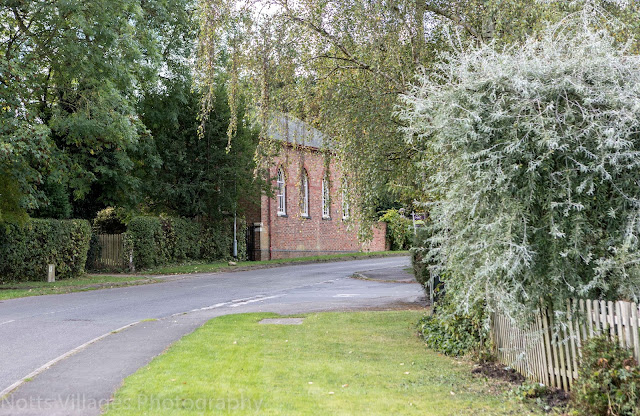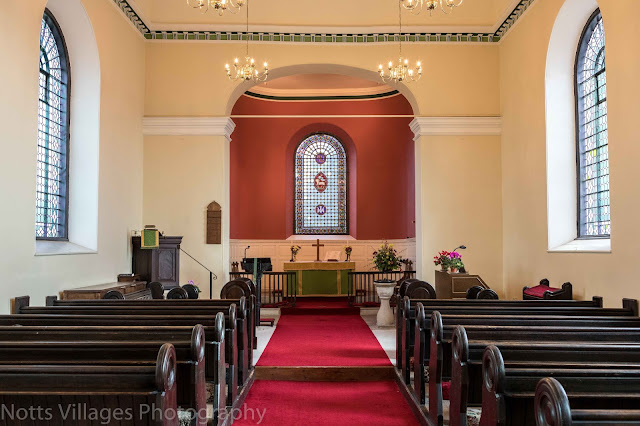 |
| Kinoulton village |
If the name of Arthur Lowe is mentioned people today probably imagine
the officious Dad's Army character ("Don't tell them your name, Pike!").
Well the Arthur Lowe
who lived in Kinoulton was not that one ... this Arthur Lowe (1865 -
1940) was a Fellow of the Royal Society of Arts. No, I had never heard
of him either but Monet and Turner spring to mind when you look at his
paintings - most of which show scenes from around Kinoulton. This one is in fact entitled Kinoulton Village:
Here is the Grantham Canal:
During his life time he exhibited at Nottingham Castle and at the Royal Academy amongst other places. After his death in 1940, at Kinoulton, his widow donated his work to different galleries around the north of England. I think Nottingham Castle should borrow them all back for an exhibition.
 |
| Village Sign |
Kinoulton is surprisingly large .... but the present village boundary incorporates the historical sites of more than one village and its centre has moved about over the course of the centuries!
The name indicates the village was originally a tun or farmstead. It belonged to a wealthy woman named Cynehild. The Domesday Book records it as Chineltune, no church is recorded and it had very little value (being worth only 2s 8d). The lost village of Newbold, just next door, was far more significant ... £10 in the Domesday accounts. The lord of the manor at the time was Morcar (died 1087), the Earl of Northumbria. Here was a powerful family. His grandmother was the wonderful Lady Godiva and his sister, Ealdgyth, was married to King Harold. In 1066 Morcar and his brother were defeated in battle at York when Harold's brother Tostig made a bid for the English crown. Harold had to quickly march north to save the kingdom at the Battle of Stamford Bridge. William the Conqueror in the meantime landed at Hastings and had plenty of time to organise his troops before the exhausted English army marched south again to be defeated. Morcar and his men did not turn up for the Battle of Hastings and later submitted to the newly crowned William so keeping his lands and titles.
Over the next few years Morcar fell in and out of favour with William but by 1071 William decided he was sick of Morcar's insubordination and threw him into a dungeon. The Newbold manor was given to William Peverel ... one of 164 given to him at the time! He was obviously a favourite of the king but then rumour had it that Peverel was William the Conqueror's illegitimate son.
Today the foundations of the manor house and the surrounding crofts and tracks are still visible from aerial photographs and Newbold is a listed and protected site under Historic England but for many years the village had faded from memory. It is not clear why it was deserted but some historians think its close proximity to Colston Bassett probably holds the answer. In 1604 Colston Bassett suffered a terrible plague: the village was completely closed off for a time and historians think the Newbold villagers took themselves away to safer places.
A second 'lost village' that made up present day Kinoulton was Warberge. It lay on the Plumtree side but very little else is known about it.
 |
| Mosiac of the church embedded in the church path. |
During the 12th century the de Villiers family were lords of Kinoulton (looking after it for the real owners, the Butlers of Warrington). Now we came across the de Villiers at Tythby (remember poor little Beatrix de Villiers madly in love with King John but he forced her to marry one of his noblemen?) Well, the family seat here was Kinoulton Castle, a defensive structure. Yes, a castle! Now don't start imagining large stone turrets and deep moats ... this was not fortified. There was a civil war taking place at the time. The de Villiers together with the Butlers of Warrington fought under Ranulph, Earl of Chester, and supported the future King Henry II. Just up the road at Gotham the Earl of Leicester also had a castle. He hated Ranulph and supported King Stephen but the de Villiers and Leicester made a pact as neither wanted the expense or inconvenience of having to defend their lands. After Stephen's death in 1154 Henry II became king and demanded the destruction of all unlicensed castles so Kinoulton Castle disappeared. (The deVilliers family didn't disappear though ... in the 1600s George de Villiers was to be the bedfellow of King James I; close advisor to Charles I and son-in-law to the Earl of Rutland).
 |
| Chapel...now a private residence. |
There is a tale that Archbishop Cranmer had a palace in Kinoulton. Apparently it used to stand near the site of the old church on the hill and had been converted into a grange. Briscoe writing Old Nottinghamshire in 1884 agreed that this was possibly the case. He explained that until 1793 the village church was St Wilfrid Church which had been built during the 12th century by Roger Archbishop of York. Cranmer was a prelate for the see of York before being promoted to Archbishop of Canterbury so it is possible he had some connection to this parish as it is so close to his Aslockton birthplace. Kinoulton parish was a 'Peculiar' which meant vicars there had the power to hold civil courts; he could grant marriage licences, hold probate and dish out punishments for misdemeanours. This status had arisen because the archbishop of York once had a residency in the area. According to one 18th century incumbent, "... four Archbishops of York resided sometimes at their palace here; no trace of which remains except the moat." so we know there is an archbishop connection but there is no evidence to suggest Cranmer had any official connection with this parish.
 |
| The Hall |
 |
| The church graveyard. |
St Wilfrid church stood on a hill about a mile outside of the present day village. Many years ago a large old granite stone also stood in the middle of the fields near the church. Today we would have seen it and deduced a glacier had dumped it there. Very logical ... the residents of Kinoulton were far more imaginative! Apparently when St Wilfrid's was newly built the devil himself was visiting Lincoln and was so furious at the sight of the new structure he threw the rock intending to destroy the little church. Luckily he missed. White (History of Nottinghamshire 1832) says the rock was part of a druid temple but it had been broken up and used for building material before his book was published.
 |
| St. Luke's |
Time did the devil's work ... the church fell into disrepair and by 1780 the village congregation were using a more conveniently placed chapel (probably an old barn) near the village centre. The Earl of Gainsbourgh stepped in and built St Luke's Church in 1793 using bricks from the local brick yard. Only the foundations of the old church remain ... and few gravestones. I wonder if it was one of these 'abandoned' headstones that a village baker used to line his oven. An old local story tells us the baker was discovered when a customer noticed his bread was imprinted with "in loving memory".
 |
| St. Luke's interior |
We visited on a Sunday so it is hardly surprising that the church was busy but the service had ended and the people had all stayed to chat and enjoy a coffee. They were most friendly and welcoming, taking us inside to show off their well kept Georgian church. They have rearranged the pews to make room for a small coffee area and once a week the building turns into a Post Office ... very convenient!
 |
| Stained glass window. |
 |
| Stained glass window. |
The Earl of Gainsborough who built the church was Charles Henry Neville Noel Esq. The very welcoming village pub is called the Nevile Arms (with one L). Part of the famous family from the Tudor court. *
 |
| The Nevile Arms and balloon! |
In 1928 Sir William Jesse Hind, a wealthy Nottingham solicitor, bought the pub and changed the name to the Hind Arms. The locals were not impressed and mounted a petition to get it changed back. Sir Jesse left a different landmark behind but that too has sadly disappeared for the time being. He planted a row of 184 poplar trees along Vimy Ridge (that runs between Owthorpe Lane and the canal tow path) that until recently could be seen for miles around. They were planted to commemorate the death of his son, Jesse Francis Montague ( "Monty "), and other fellow officers at the Battle of the Somme during the First World War. Unfortunately the trees grew to over 90 feet and became quite hazardous so had to be felled in February 1998. Saplings have been planted in their place so the landmark will return given time.
 |
| A tree stump near this sign is all that remains of "the splendid Turkey oak, perhaps commemorating victory in the Crimea" mentioned in The Nottinghamshire Village Book (1989) produced by the WI. |
I would liked to have met Sir Jesse Hind. He sounds like a very social minded person. He is described as the "Friend of Crippled Soldiers". Following his son's death he founded and equipped a pioneering orthopaedic ward to treat injured servicemen. His farm at Kilnoulton was an agricultural training ground where ex-servicemen and orphans could gain qualifications and work experience all at Jesse Hind's expense.
 |
| The Old Bakehouse. |
In 1769 Kinoulton became quite famous as a spa retreat and dressing rooms were constructed near a local spring after the water was said to have healing properties. The spa is named on modern maps but the paths to it are overgrown now.
 |
| Bailey Row |
Village life today is still based around rural activities but a large proportion of the residents now commute elsewhere for work. The old barns have been converted into comfortable homes for people not animals and the rows of workers' cottages given a facelift. The Grantham Canal is no longer filled with brick and coal barges and the towpaths are used for country walks. The village has changed with the times.
 |
| The Nevile Arms |
 |
| Nevile Arms and hot-air balloon |
 |
| Hot-air balloon over Kinoulton |
Map of Kinoulton: click here.
 |
| Old safe |
References:
History of Nottinghamshire by W White (1832)
The Nottinghamshire Village Book By Notts WI (1989)
Old Nottinghamshire by J P Briscoe (1884)
Nottinghamshire Guardian by W E Doubleday
* An "aside": Some modern literary scholars claim that William Shakespeare was not actually the author of the plays: Henry Neville has been put forward as the real genius behind the name. Another candidate is Roger Manners the 6th Earl of Rutland (more information here).

